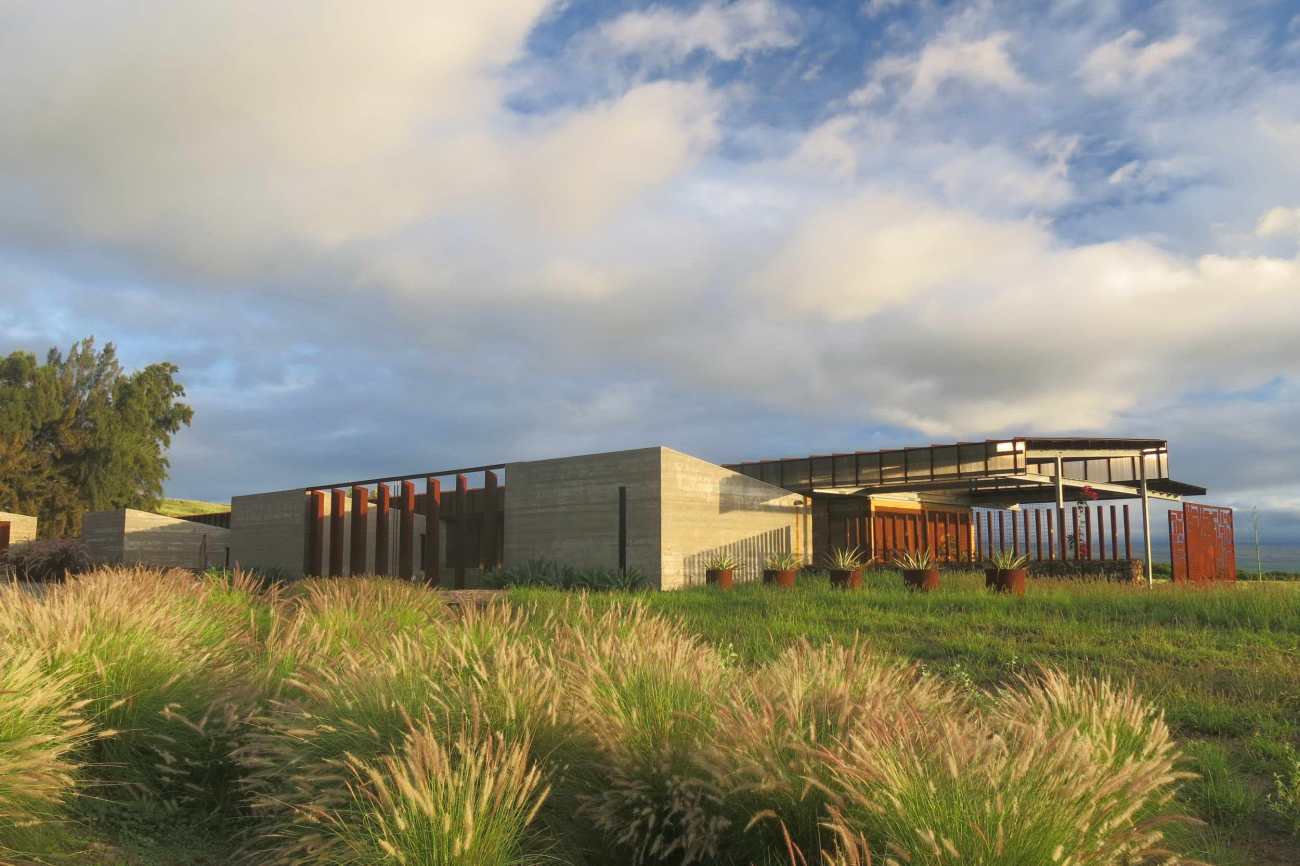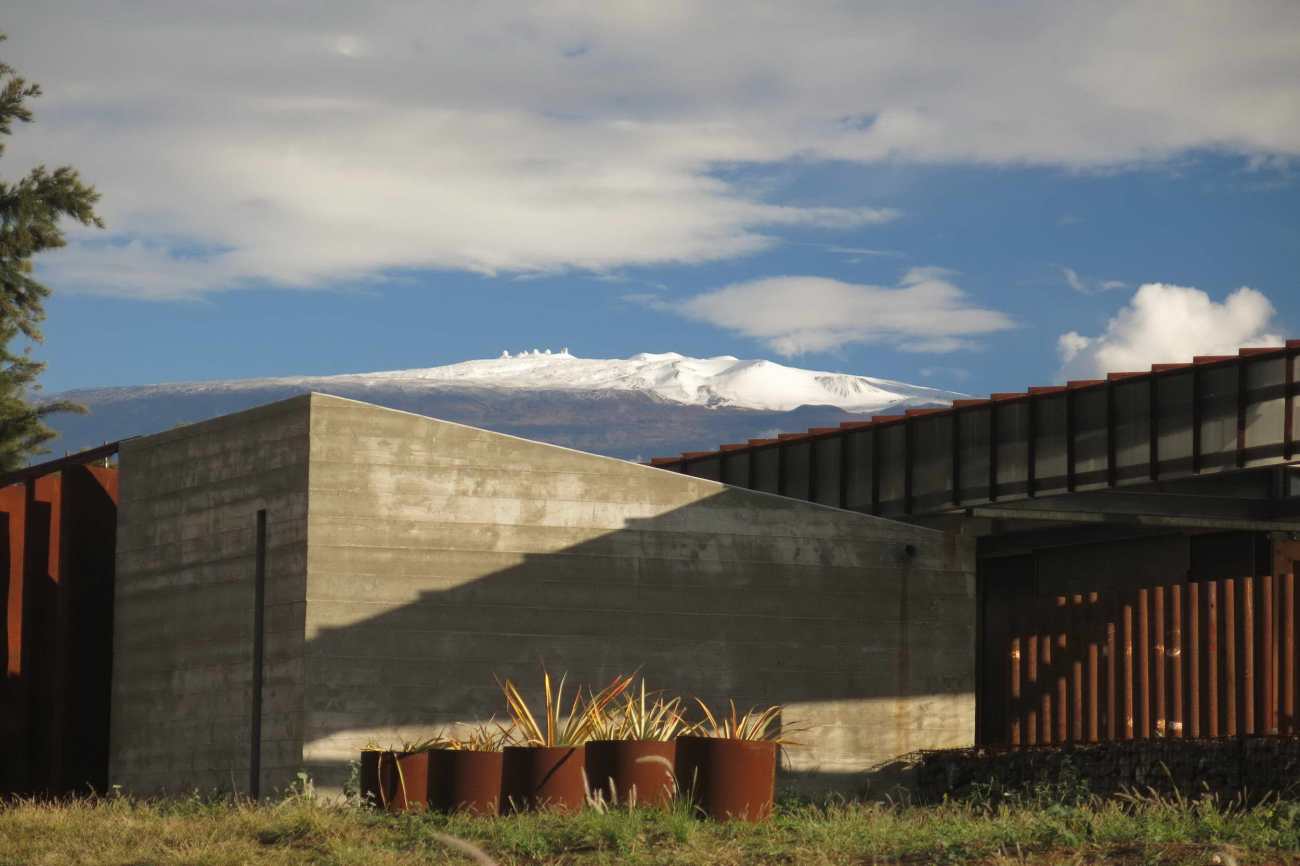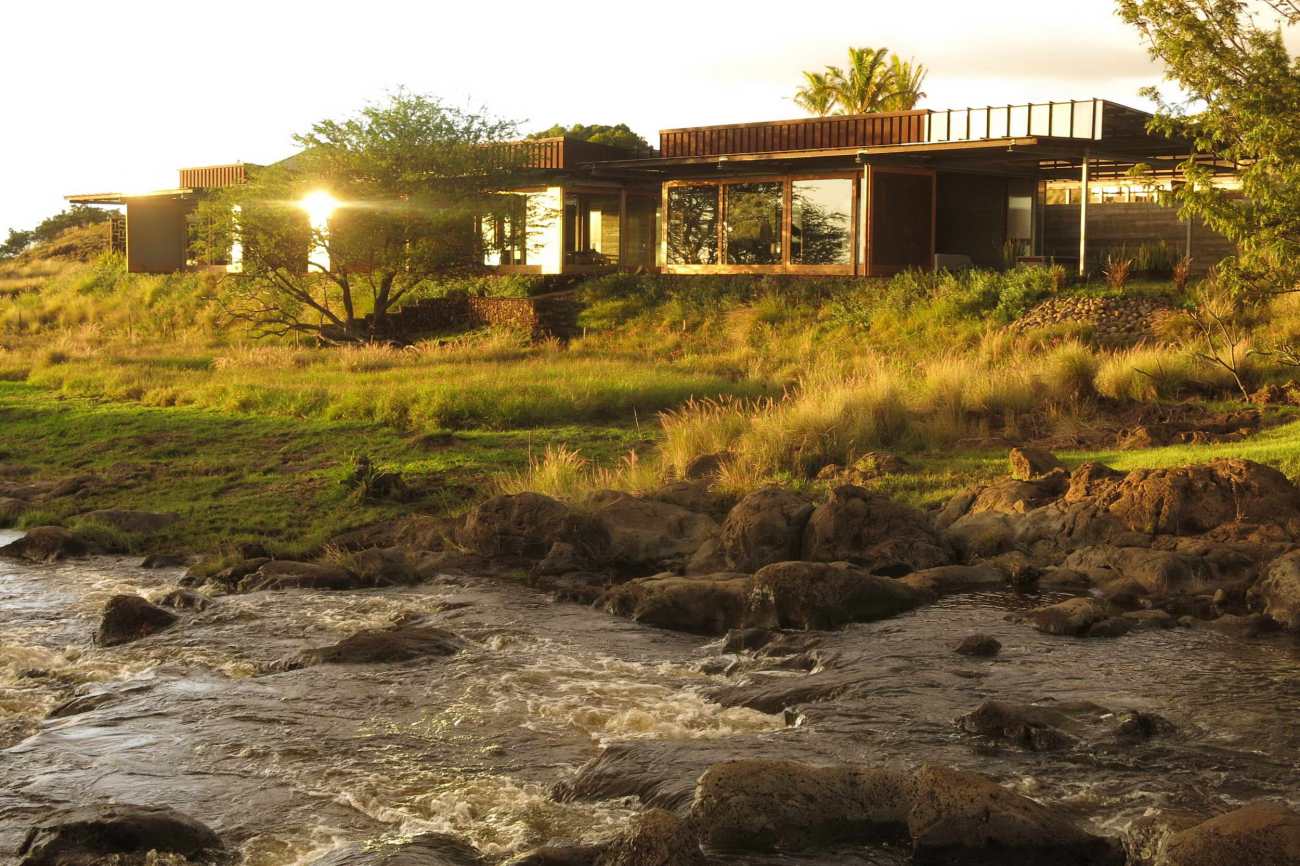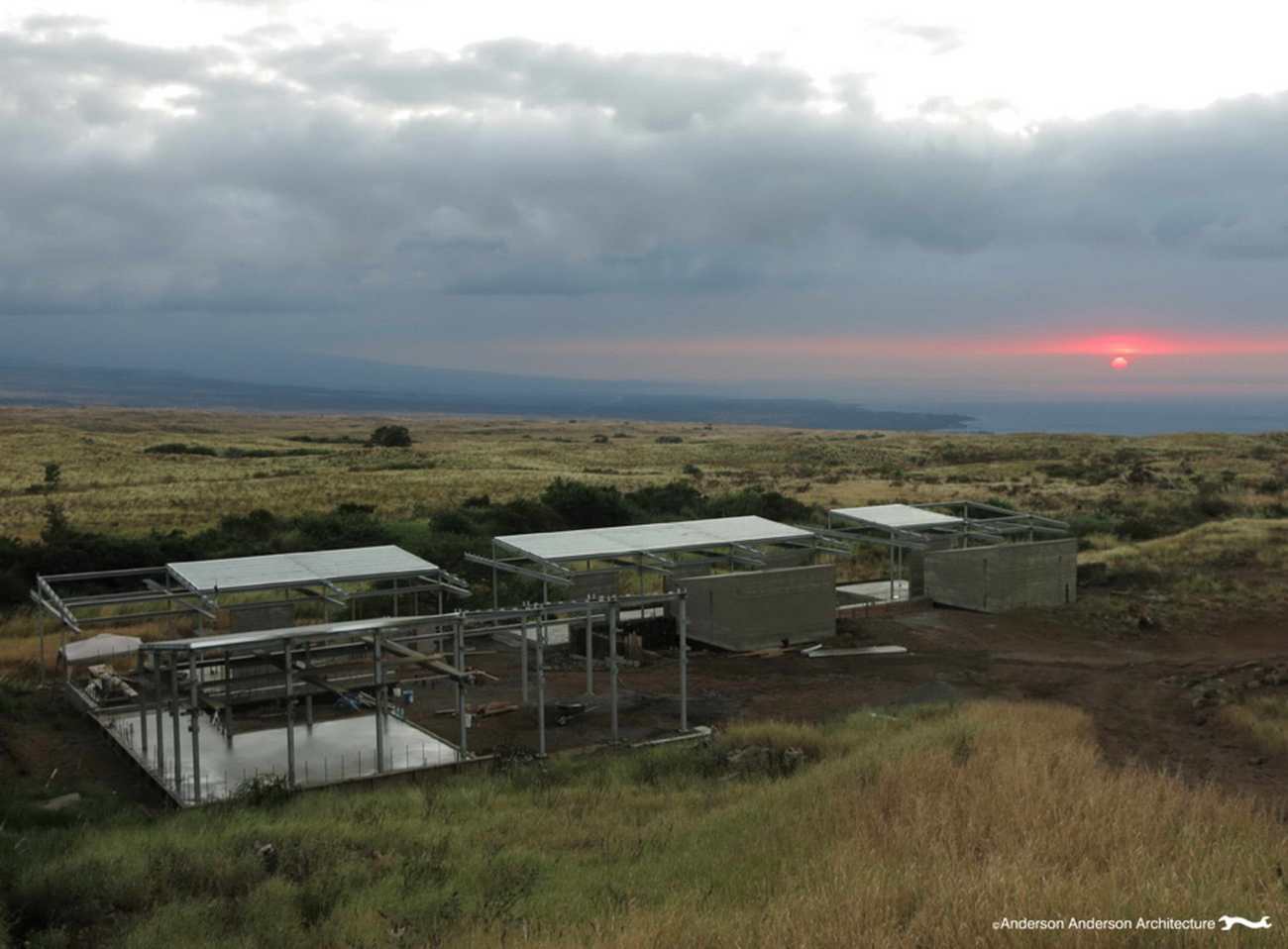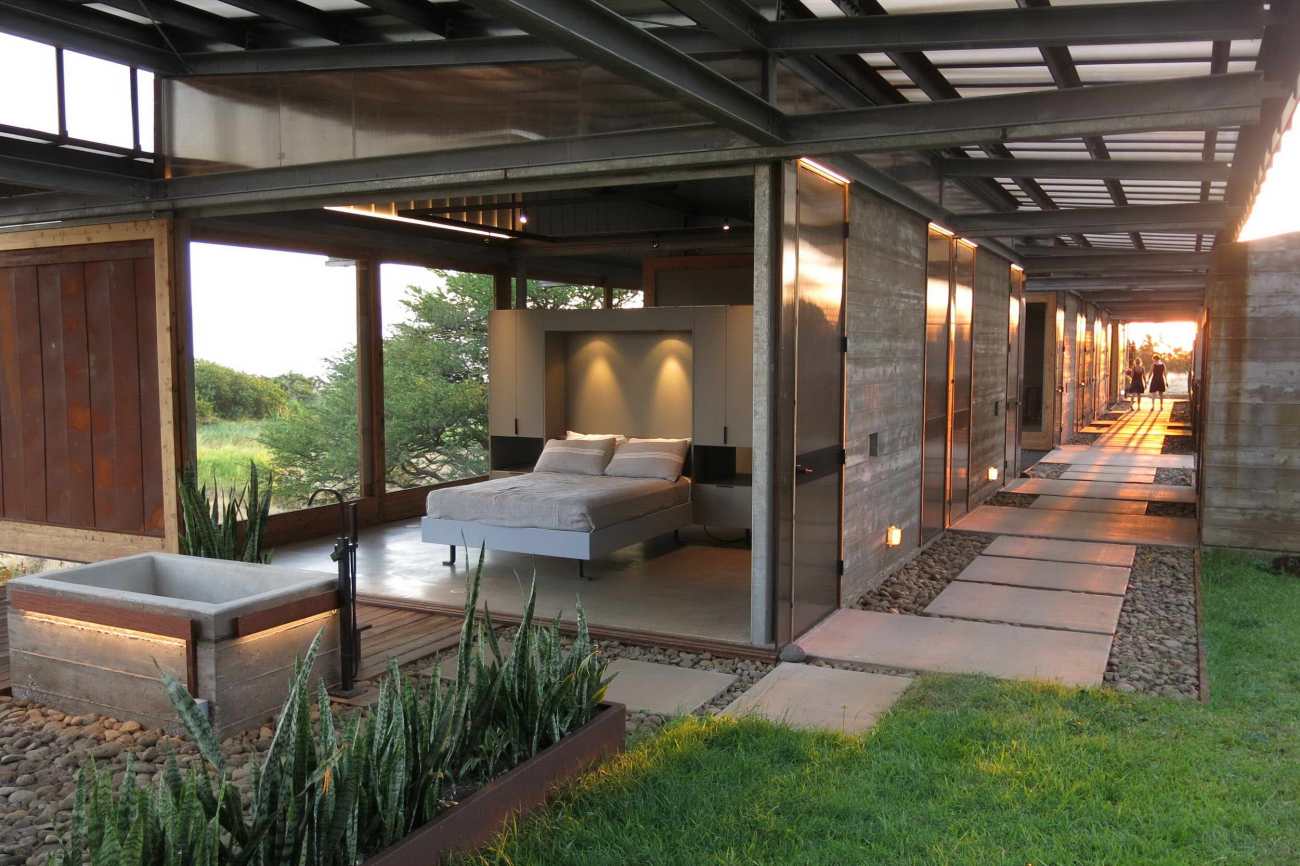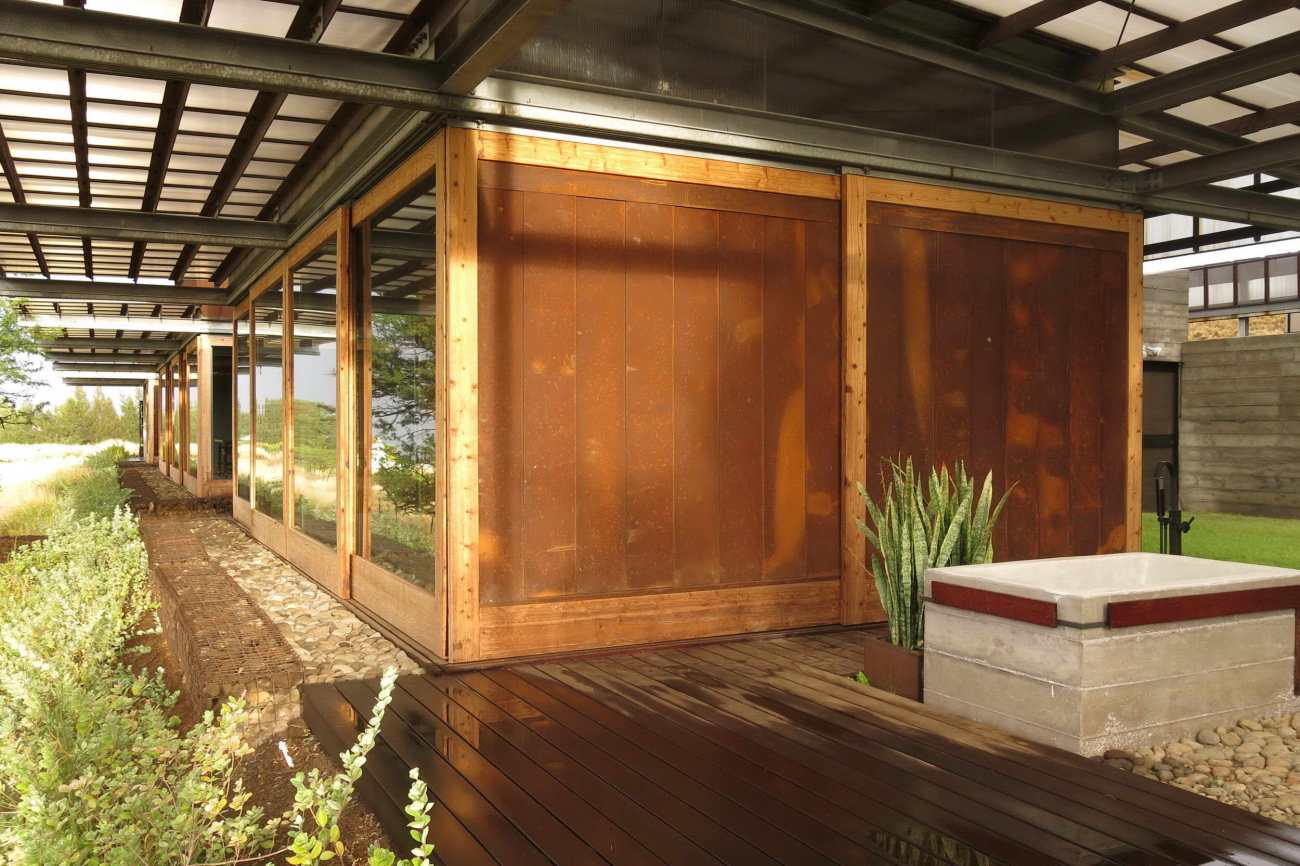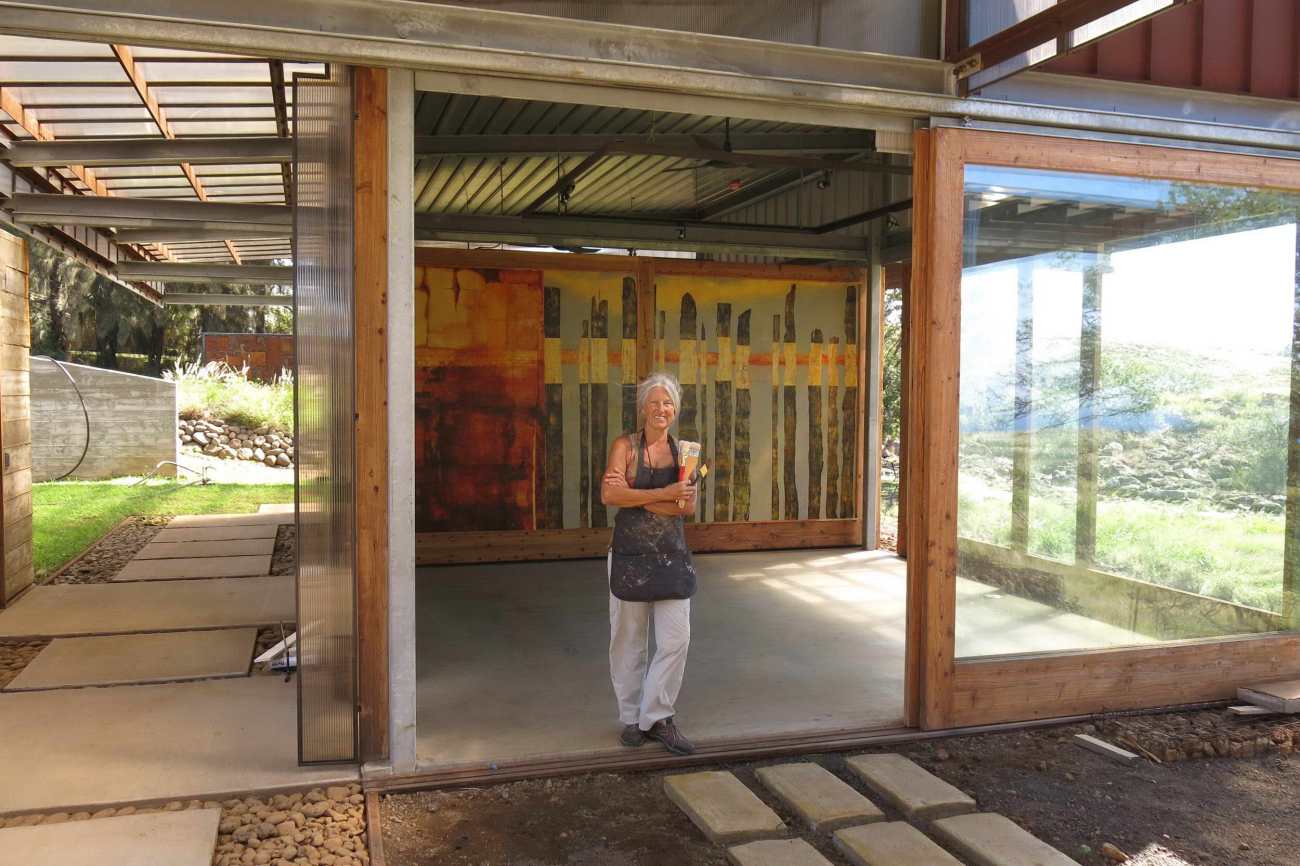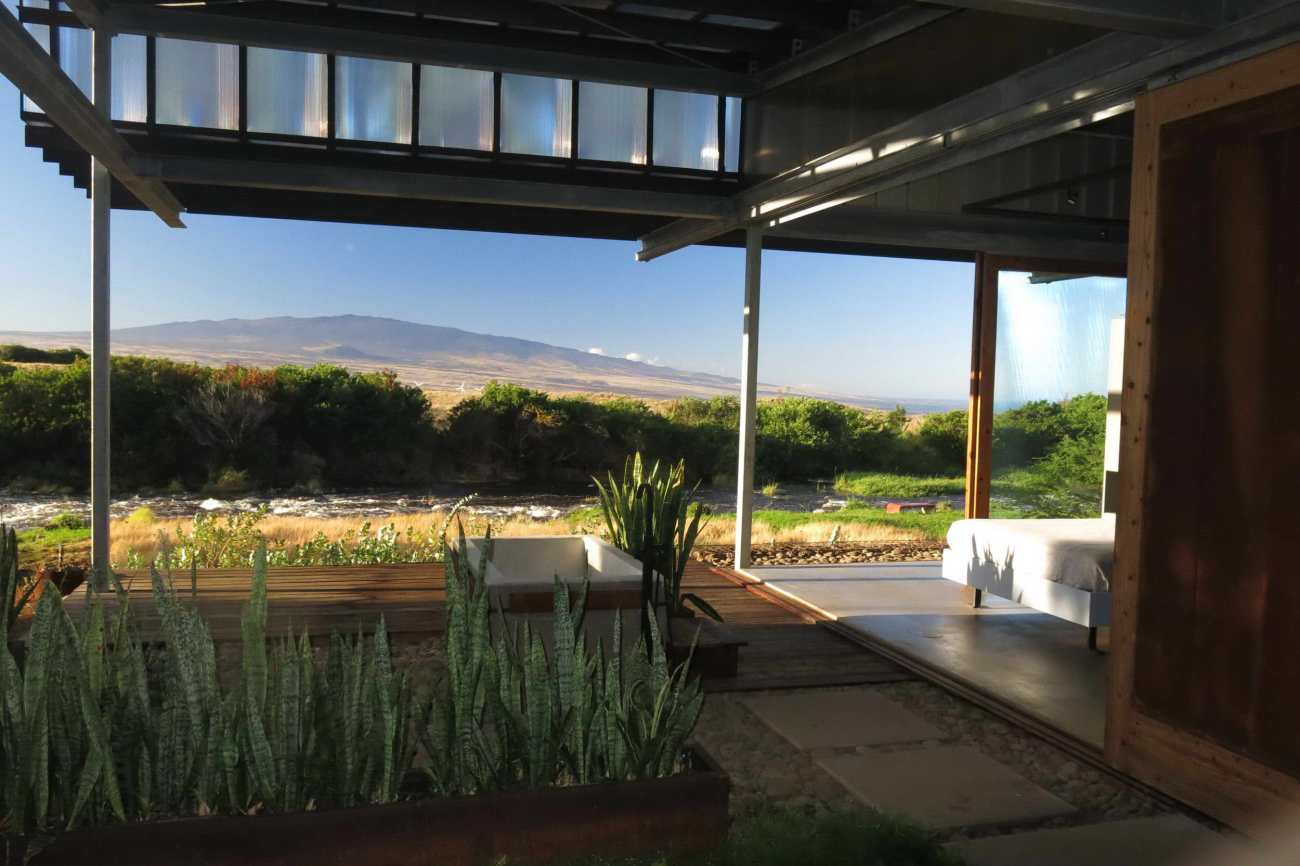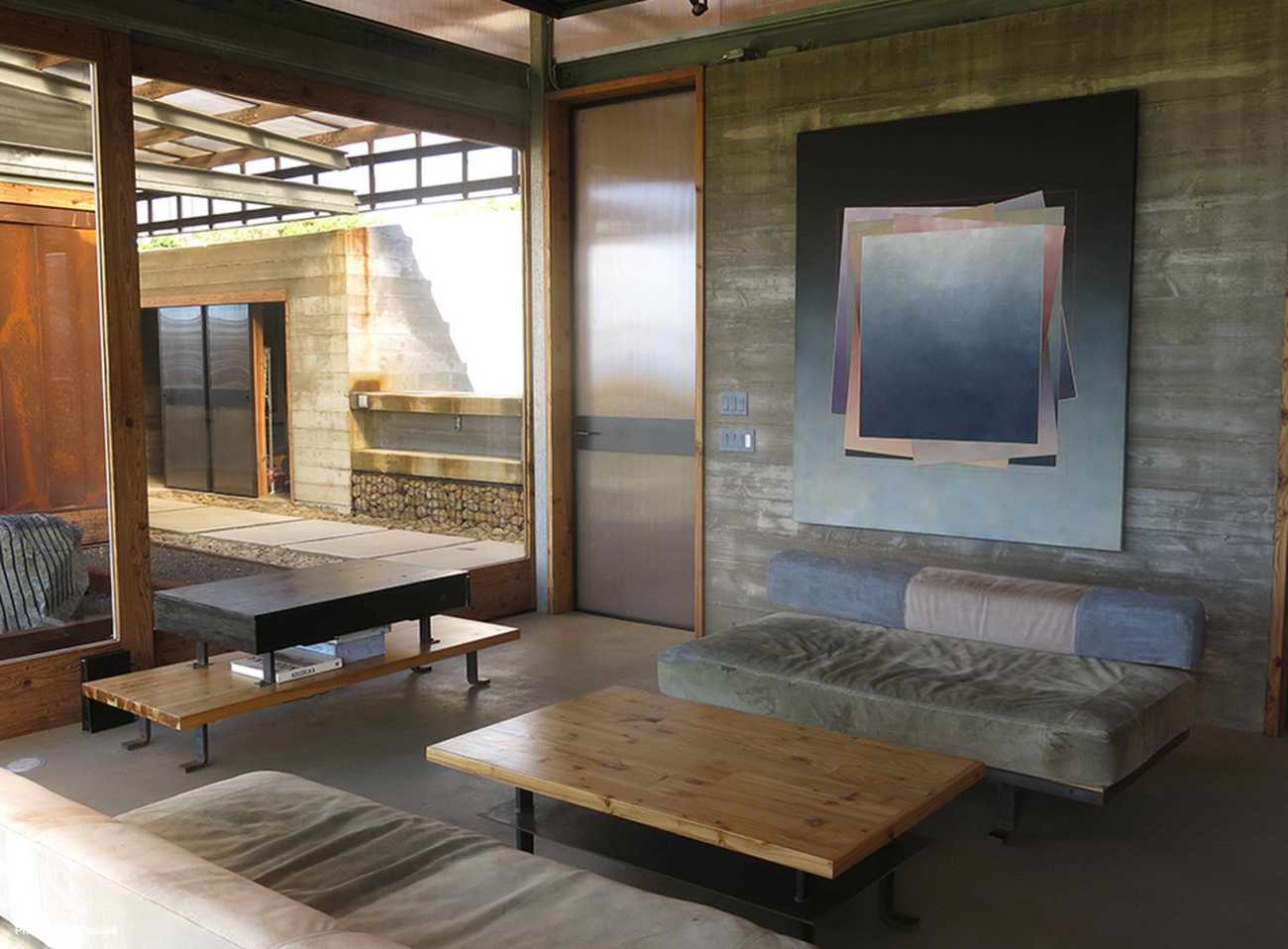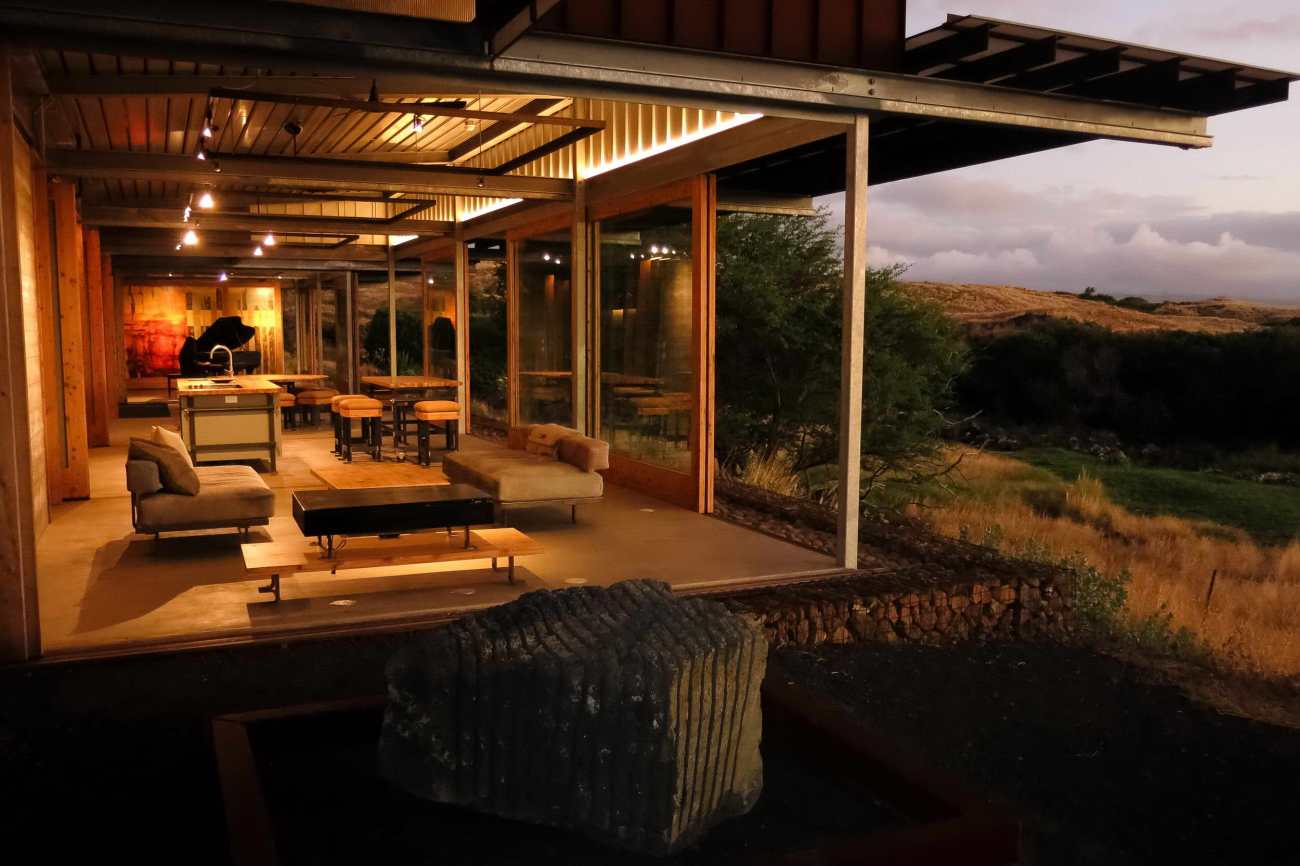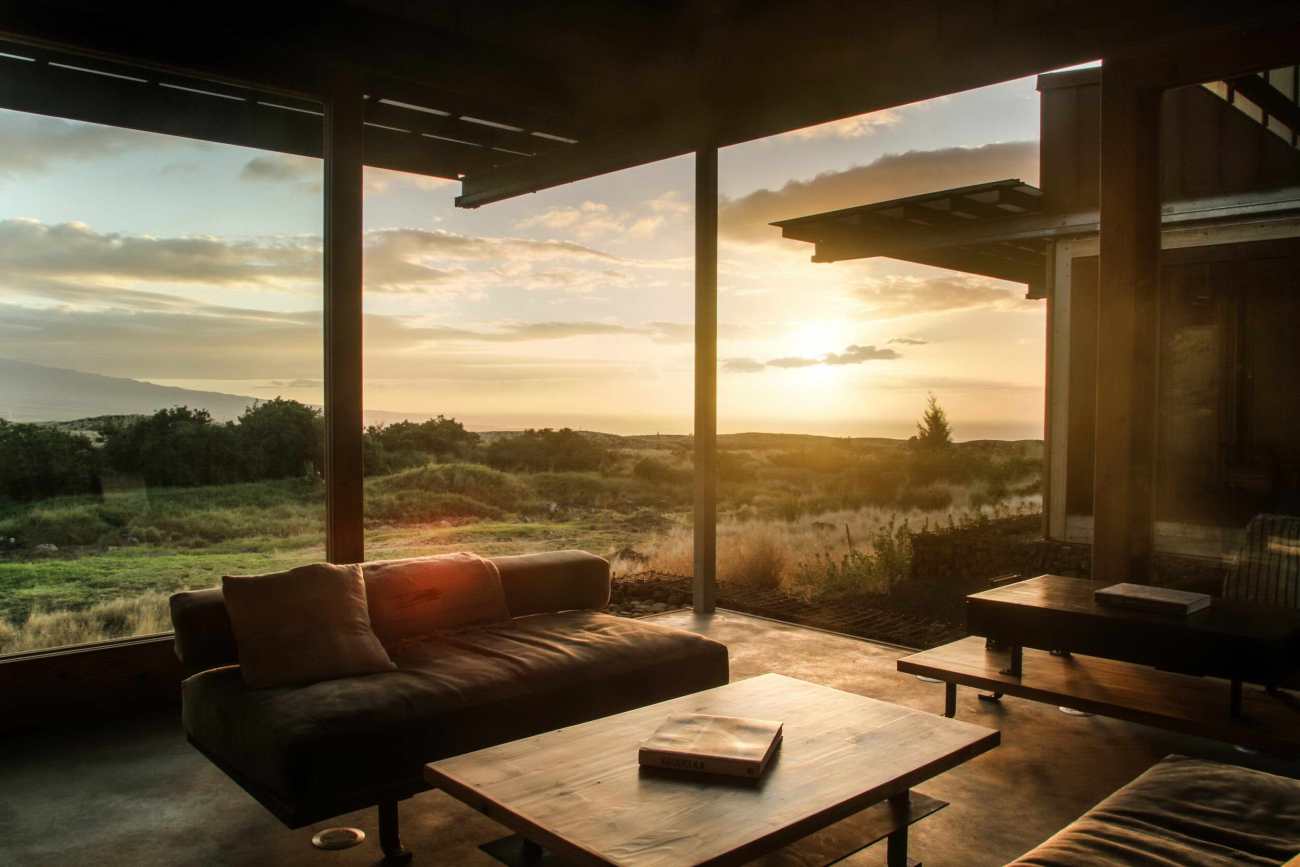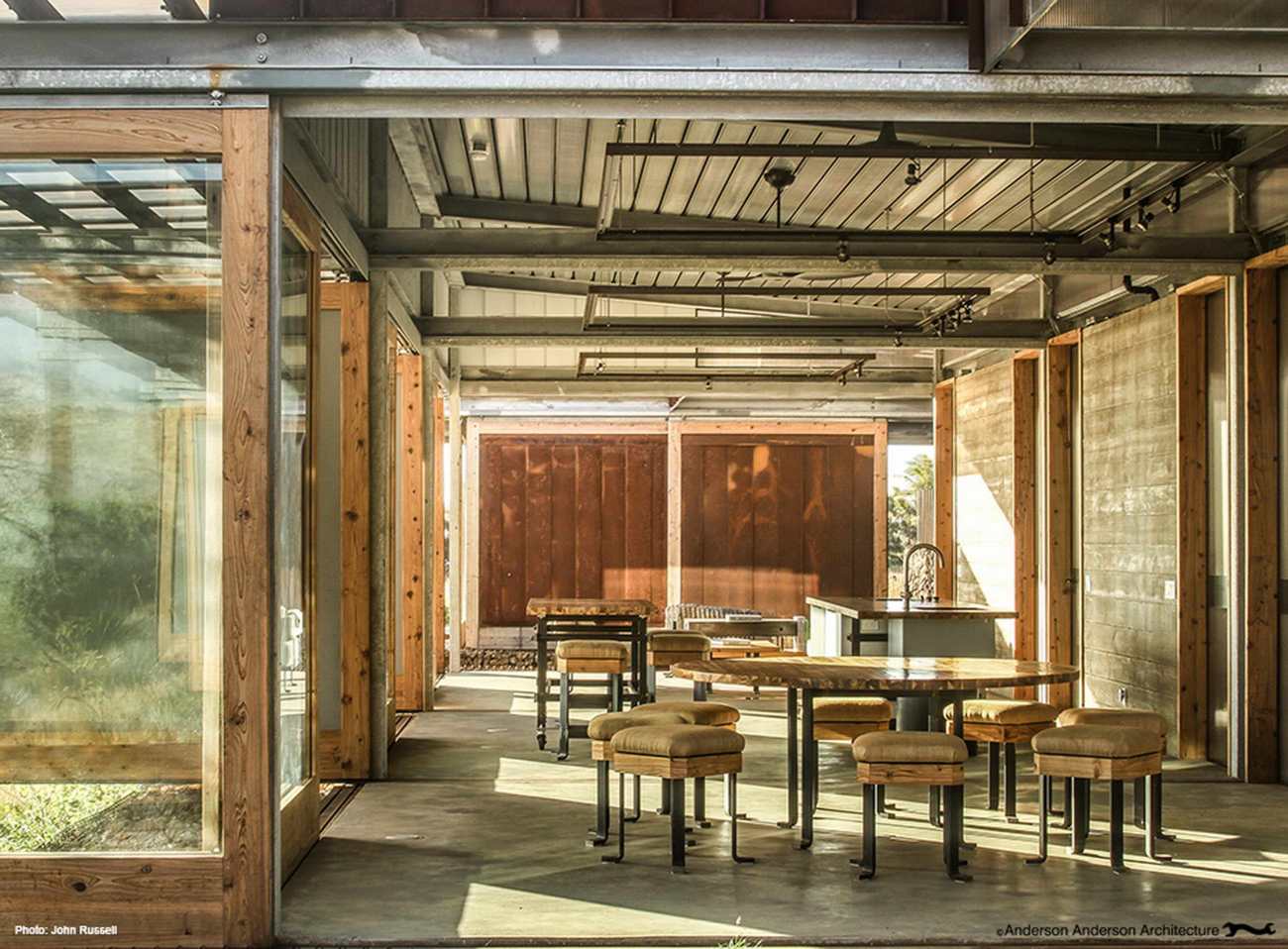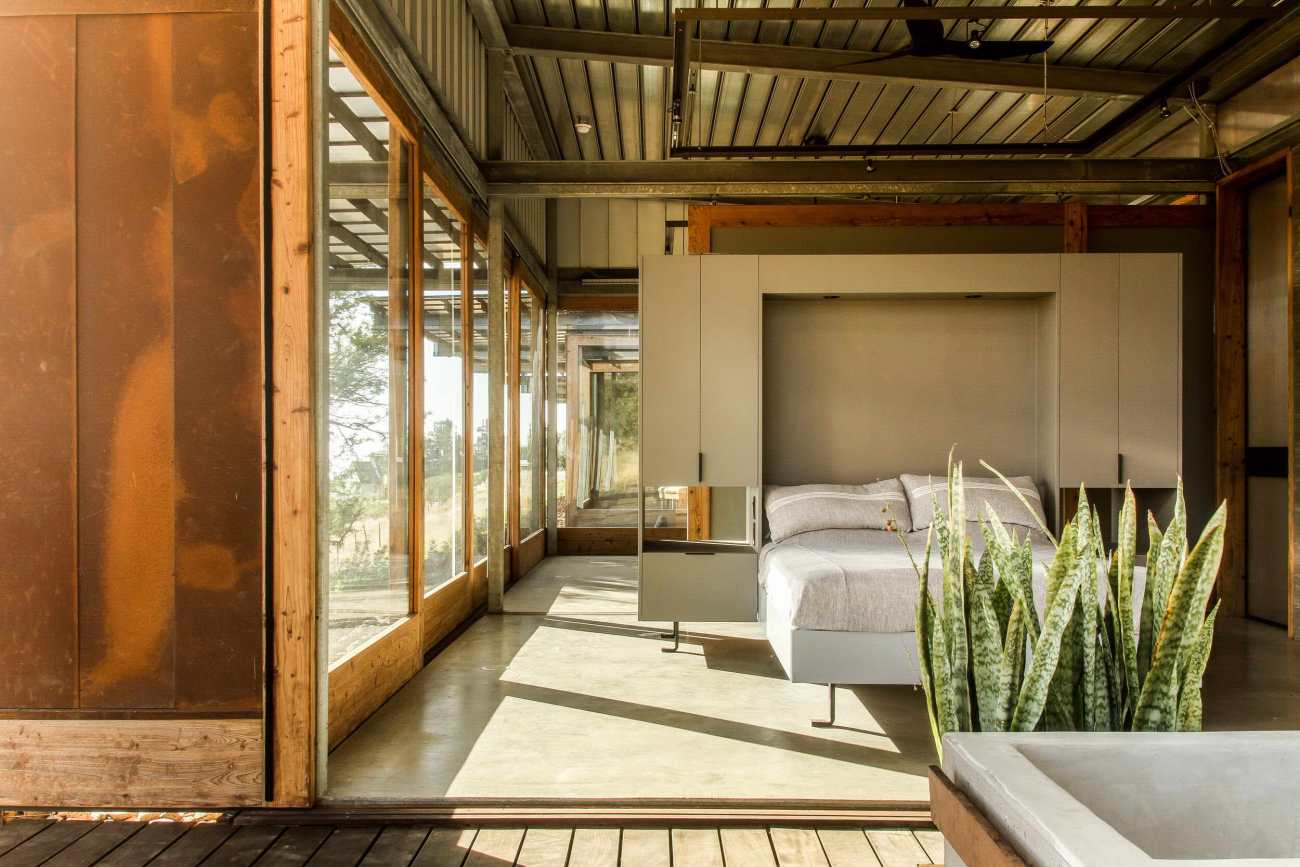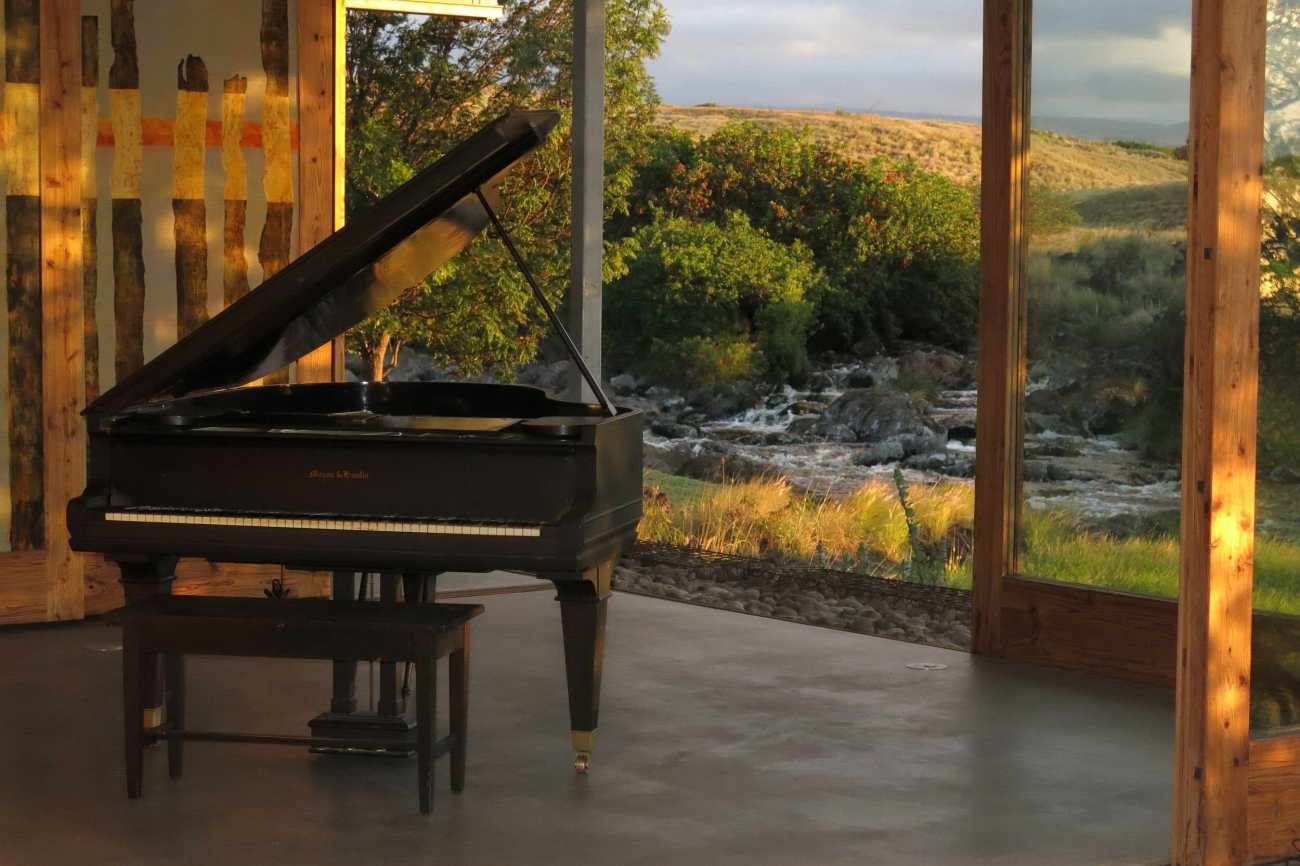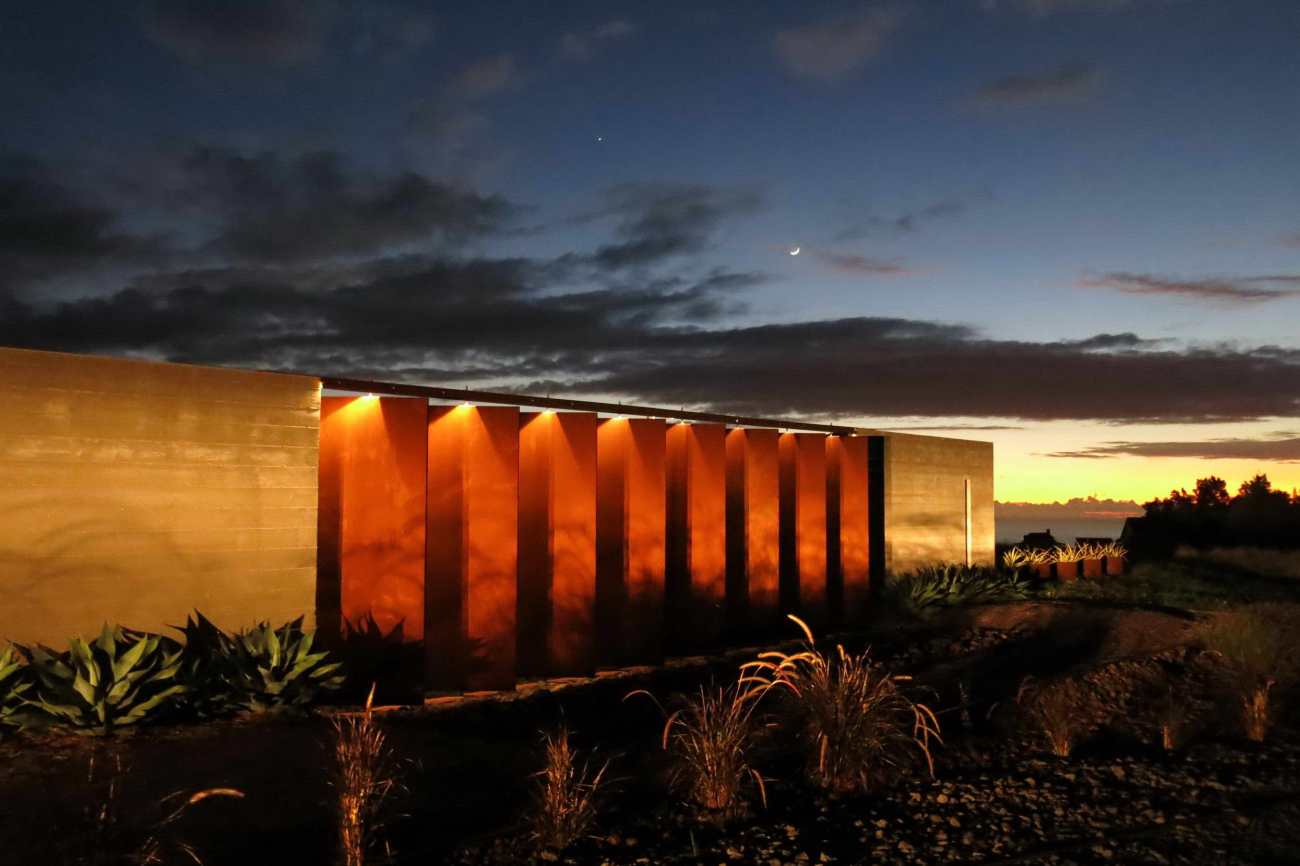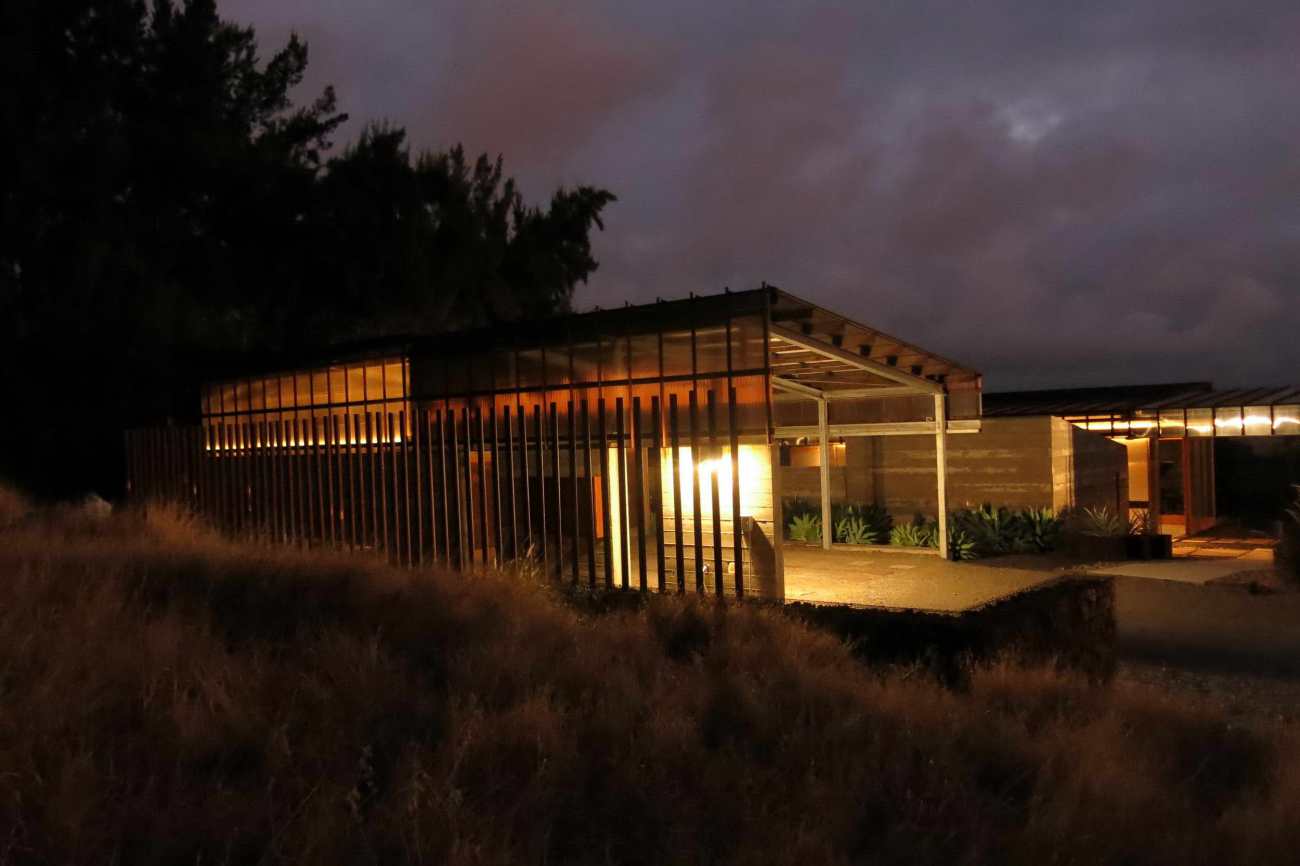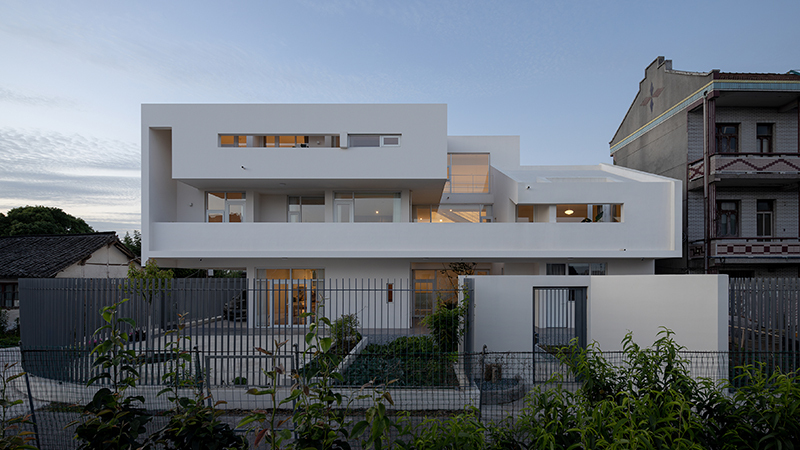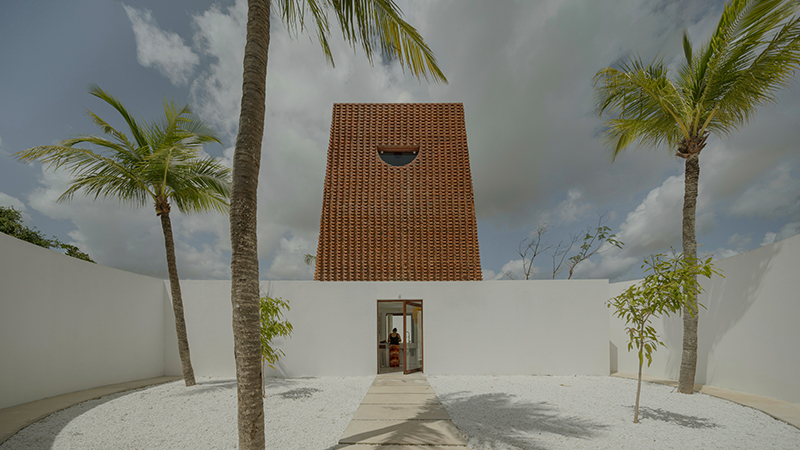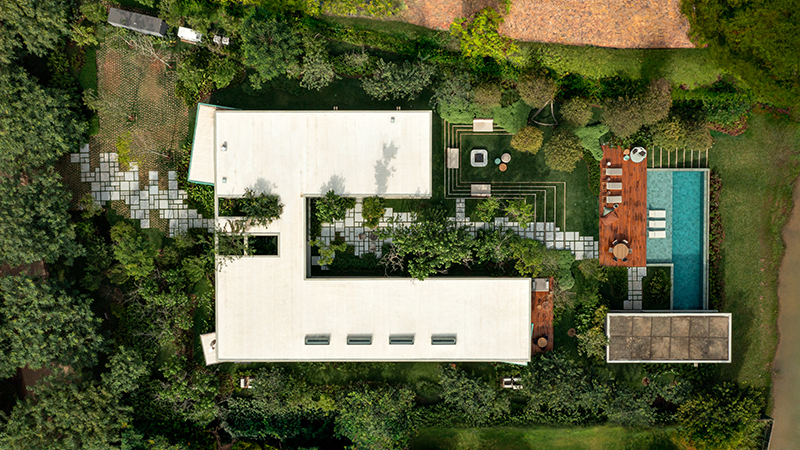| 公司: | Anderson Anderson Architecture | 类型: | 建筑 |
|---|---|---|---|
| 地区: | 美国 | 标签: | 别墅私宅 |
这个项目建在夏威夷大岛的沙漠高地,靠近乡村小镇威美亚。业主是一个由艺术家和专业厨师组成的多代同堂的家庭,他们将这个空间用于生活和工作、客户客人、晚宴和艺术活动。
This project is built on the desert highlands of the Big Island, Hawaii, near the rural town of Waimea. The owners are a multi-generational family of artists and professional chefs who use the space for life and work, client guests, dinner parties and arts events.
房子坐落在一个干燥的山坡上,面向南方,可以看到三座高耸的火山峰、巨大的熔岩悬崖和广阔的太平洋,每当雨水落在北边高高耸立的云层悬崖上时,房子的脚下就会有一条狂野的偶发性溪流通过沙漠中的岩石瀑布。从同样的悬崖上,狂暴的贸易风吹拂着房子的北面,因此,房子的北面被掩埋在这个上升的迎风面,它的屋顶倾斜起来,足以引导空气上升,并为室内和室外的庭院提供庇护。
Sited on a dry hillside facing southward with sweeping views of three towering volcano peaks, vast lava escarpments and a broad expanse of Pacific Ocean, the house rests within feet of a wild episodic stream cascading through its course of desert rocks whenever rain falls on the continually cloud-capped cliffs towering high above the house to the north. From these same cliffs raging trade winds buffet the north face of the house, which is consequently bunkered low into this rising windward flank, with its roof tipped up just enough to guide the air up and over to shelter indoor and outdoor courtyards.
当位于不断展开的戏剧性天气现象中时,模块化的建筑元素创造了一个理想的生活和工作场所,几乎完全在户外,享受温暖的阳光,美丽的景色,在环境强度的超凡体验中享受静谧的口袋。这个项目的意图是基本的--以最少的干预和只用最原始的材料建造,使在这个野生场地上舒适地生活在户外成为可能。这种意图要求通过部署最少数量的必要的简单结构,对风、光、温度、湿度和景观进行深思熟虑的塑造,以实现预期的体验塑造。
While situated within ever-unfolding dramatic weather phenomena, the modulating construction elements create an ideal place to live and work almost entirely outdoors, enjoying warm sunlight, beautiful views, pockets of still quiet amid transcendent experience of environmental intensity. The intention of this project is elemental—to make it possible to live comfortably outdoors on this wild site with minimal intervention and only the rawest material construction. This intention requires thoughtful shaping of wind, light, temperature, humidity and views by deploying a minimal number of simple constructions necessary to effect the intended experiential shaping.
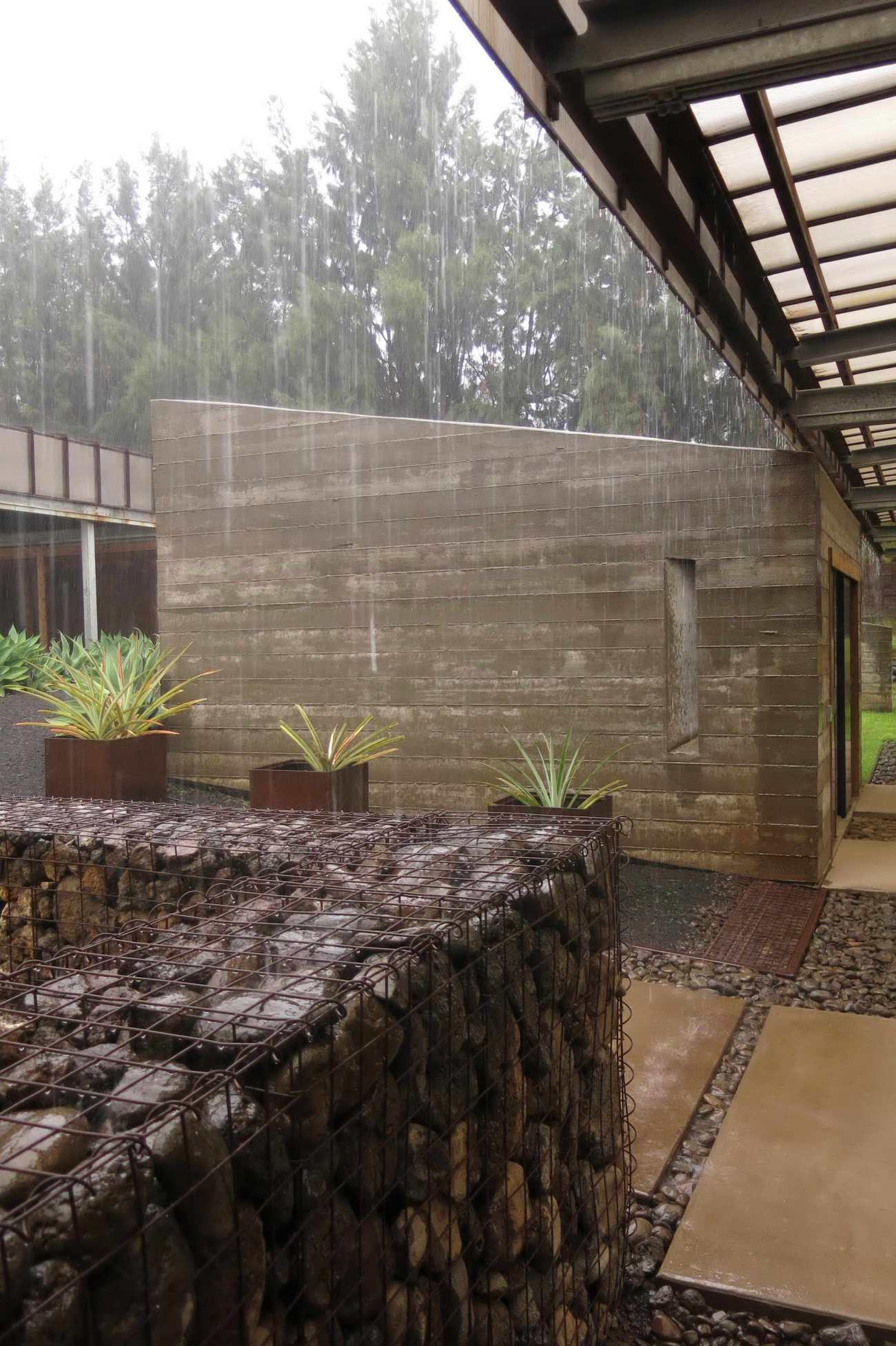 |  |
由于项目场地周边的材料和劳动力有限,因此材料的选择最大限度地实现了轻质元素的异地预制,并结合当地的质量和自然地形,以最大限度地减少平整和景观重建。所有来自异地的材料都是轻质和金属,而来自当地地面的材料则包括最原始的混凝土和当地的木材、熔岩石和砾石。在这个水资源稀缺的干涸景观中,没有添加任何植物,但却小心翼翼地保留着目前生存在这里的所有生命,并将人类的生活和体验结构化,以满足随着时间的推移自然风回屋内的细微景观生命。建筑材料的色调非常有限。
Since limited materials and labor are available at this location, the palette of materials is selected to maximize off-site prefabrication of lightweight elements and to incorporate local mass and natural topography in order to minimize grading and landscape reconstruction. All that is from off-site is lightweight and metal, while that from the local ground consists of the rawest possible placement of concrete and local wood, lava stone and gravel. No plants are added to this parched landscape with its scarce water resources, but care is taken to preserve all life currently surviving here, and to structure human life and experience to be satisfied with the subtle landscape life that will wind back into the house naturally over time. There is a very limited palette of construction materials.
 | 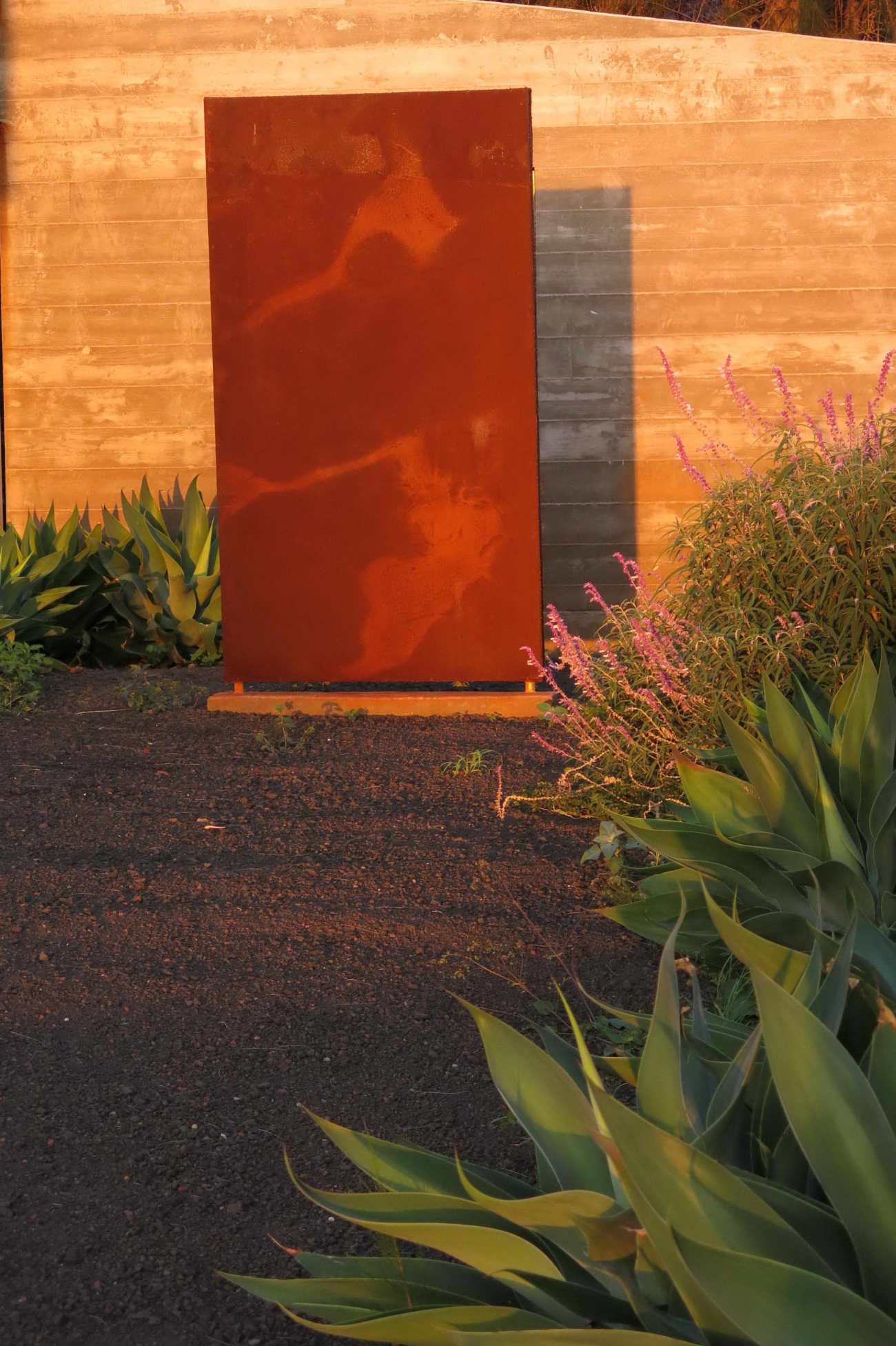 |  |
现场浇筑的混凝土,当地硬木,预制的镀锌钢,预制的耐候钢板,当地的熔岩和蓝石砾石,玻璃和半透明的聚碳酸酯,有限的五金、电器、固定装置和太阳能板。房子是离网的,自给自足,所有的电力都由屋顶光伏阵列提供。能源使用,光和声音的入侵最小化,全LED照明,自然通风和冷却,完全不需要空调。
Site cast concrete; local hardwoods; prefabricated galvanized steel; prefabricated weathering sheet steel; local lava rock and blue stone gravel; glass and translucent polycarbonate; a limited range of manufactured hardware, appliances, fixtures and solar panels. The house is off-grid and self-contained with all power provided by a rooftop PV array. Energy use, light and sound intrusion are minimized with all-LED lighting, natural ventilation and cooling, no mechanical conditioning.
该住宅被设想为一个可调节的工具,在这个特殊的、不断变化的和无情的景观中促进舒适和高度变化的生活。住宅的大部分由一系列相同的轻型亭子组成,在宽阔的拱形遮阳屋顶下排成一排,具有双重功能,作为重型空气导流器和雨水收集器。相同的展馆由四面相同的滑动谷仓门封闭,在空间配置上允许极大的灵活性,提供了微调共享社区空间与隐私,以及展馆之间、外部和内部之间的围护与扩展。
The house is conceived as a tune-able instrument to facilitate comfortable and highly variable living in this special, if continually shape-shifting and unforgiving, landscape. The majority of the house consists of a series of identical lightweight pavilions, aligned in a row beneath a broad, overarching shade roof serving double-duty as a heavy-duty air deflector and rain collector. The identical pavilions are each enclosed by identical sliding barn doors on all sides, allowing great flexibility in spatial configuration offering fine tuning of shared community space vs. privacy, and enclosure vs. expansiveness between pavilions, and between exterior and interior.
这些主要的生活体量由一排重型混凝土掩体提供服务,它为一些生活和存储功能提供了高度对比的质量、凉爽性、隐私性和安全性,同时将屋顶的翅膀扎入倾斜的地面,并将亭子的排面遮挡在狂风中。嵌在掩体和滑门亭中的是一系列阴凉和开放的室外庭院空间,在场地上完整的外观之间过渡和交错,以及一系列微气候特征明显的空间藏在重复的建筑中。
These primary living pavilions are serviced by a row of heavy concrete bunkers which provide a highly contrasting mass, coolness, privacy and security for some living and storage functions, while simultaneously rooting the roof wing down into the sloping ground and shielding the pavilion row from the howling trade winds. Nestled among the bunkers and sliding-door pavilions are a series of shaded and open outdoor courtyard spaces, transitioning and interlocking between full exterior on the site, and a series of micro-climatically distinct spaces tucked among the repetitive constructions.
 |  | 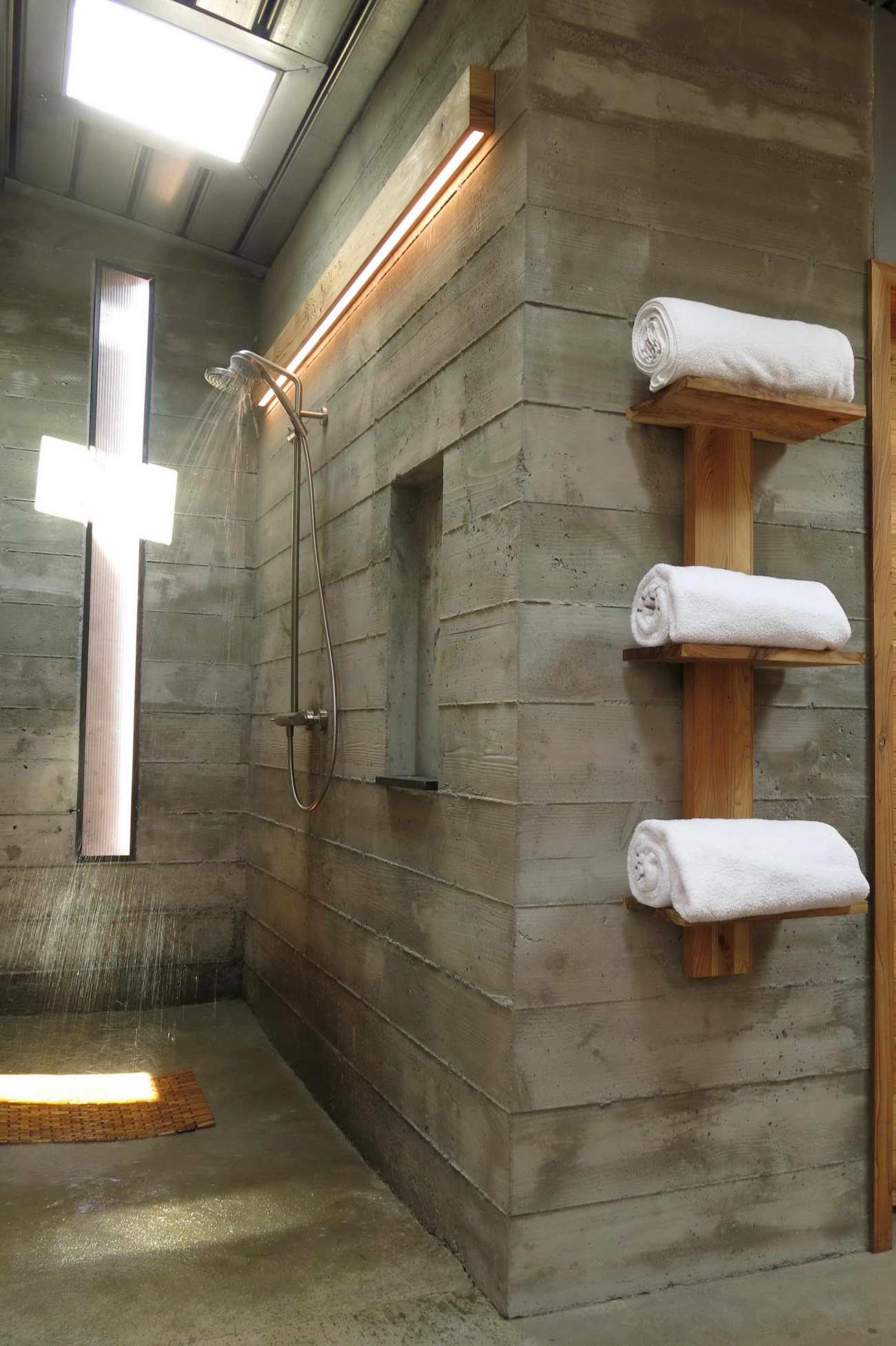 |
虽然尽一切努力将结构内各元素和位置之间的明显视觉差异降到最低,但这种努力的部署旨在为其居民创造与高度细微的外部景观和现象相关的无限变化的条件、质量和体验。通过这种方式,房子被设想为一个最小的衔接,以促进这个地方最大的生活质量和环境感知。
While every effort is made to minimize the apparent visual differentiation between elements and locations within the structure, this effort is deployed with the intent to create infinitely variable conditions, qualities and experiences for its inhabitants in relationship to the highly nuanced exterior views and phenomena. In this way, the house is conceived as a minimal armature to facilitate maximum quality of life and environmental perception in this place.
 |  |
▽场地平面图 Site plan
▽平面图 Plan
▽剖面图 Section
▽轴侧分解图 Exploded Axo
▽轴侧分解图 Exploded Axo
▽轴侧分解图 Exploded Axo
Project name: Anekona
Company name: Anderson Anderson Architecture
Website: https://andersonanderson.com
Contact e-mail: aaa@andersonanderson.com
Project location: Hawaii, Waimea
Completion Year: 2018
Building area (m²): 3399 square feet / 315.78 m²
Other participants: Mark Anderson, Peter Anderson, John Russell, Alexis Wilson Russell, Christopher Campbell, Gennifer Muñoz, Brady Quinlan, Johnson Tang, Ziang Ao, Reem Makkawi, JJ Tan, Yafei Li, Ana Perez González
Photo credits: John Russel
更新日期:2021-01-06 16:15:40
非常感谢 Anderson Anderson Architecture 带来的精彩项目, 查阅更多Appreciations towards Anderson Anderson Architecture for sharing wonderful work on hhlloo. Click to see more works!
